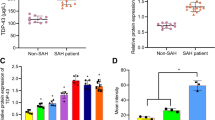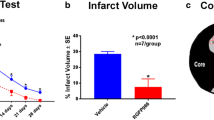Abstract
Spontaneous intracerebral hemorrhage (ICH) is a stroke subtype with no effective treatment. Though ICH is known to induce severe neurological damage, the molecular mechanisms of neurological injury after ICH remain largely unclear. Given the emerging role of epigenetic mechanisms in neurodegeneration, the present study evaluated whether suberoylanilide hydroxamic acid (SAHA: vorinostat), a clinically well-tolerated pan-histone deacetylase inhibitor (HDACi), would attenuate neurological injury and improve functional outcomes in a preclinical model of ICH. Mice were administered with SAHA or vehicle after an induction of ICH and acute neuronal death, glial activation, and neurological outcomes were assessed. SAHA-treated mice exhibited less neurodegeneration with concomitant improvement in neurological outcomes than vehicle-treated mice. Furthermore, SAHA downregulated glial activation and the expression of heme oxygenase-1, a stress-inducible enzyme that plays critical roles in neurological damage after ICH. Altogether, the data strongly suggest the role of epigenetic mechanisms in inducing neurological injury after ICH and raise the possible clinical utility of SAHA for therapeutic intervention after ICH.





Similar content being viewed by others
References
Ribo M, Grotta JC. Latest advances in intracerebral hemorrhage. Curr Neurol Neurosci Rep. 2006;6:17–22.
Morgenstern LB, Hemphill 3rd JC, Anderson C, Becker K, Broderick JP, et al. Guidelines for the management of spontaneous intracerebral hemorrhage: a guideline for healthcare professionals from the American Heart Association/American Stroke Association. Stroke. 2010;41:2108–29.
Manno EM. Update on intracerebral hemorrhage. Continuum (Minneap Minn). 2012;18:598–610.
Ciccone A, Pozzi M, Motto C, Tiraboschi P, Sterzi R. Epidemiological, clinical, and therapeutic aspects of primary intracerebral hemorrhage. Neurol Sci. 2008;29 Suppl 2:S256–7.
Yang GY, Betz AL, Chenevert TL, Brunberg JA, Hoff JT. Experimental intracerebral hemorrhage: relationship between brain edema, blood flow, and blood-brain barrier permeability in rats. J Neurosurg. 1994;81:93–102.
Wagner KR, Xi G, Hua Y, Kleinholz M, de Courten-Myers GM, et al. Lobar intracerebral hemorrhage model in pigs: rapid edema development in perihematomal white matter. Stroke. 1996;27:490–7.
Babu R, Bagley JH, Di C, Friedman AH, Adamson C. Thrombin and hemin as central factors in the mechanisms of intracerebral hemorrhage-induced secondary brain injury and as potential targets for intervention. Neurosurg Focus. 2012;32:E8.
Koeppen AH, Dickson AC, Smith J. Heme oxygenase in experimental intracerebral hemorrhage: the benefit of tin-mesoporphyrin. J Neuropathol Exp Neurol. 2004;63:587–97.
Abraham NG, Kappas A. Pharmacological and clinical aspects of heme oxygenase. Pharmacol Rev. 2008;60:79–127.
Chen M, Regan RF. Time course of increased heme oxygenase activity and expression after experimental intracerebral hemorrhage: correlation with oxidative injury. J Neurochem. 2007;103:2015–21.
Glozak MA, Sengupta N, Zhang X, Seto E. Acetylation and deacetylation of non-histone proteins. Gene. 2005;363:15–23.
Verdone L, Caserta M, Di Mauro E. Role of histone acetylation in the control of gene expression. Biochem Cell Biol. 2005;83:344–53.
Rouaux C, Jokic N, Mbebi C, Boutillier S, Loeffler JP, et al. Critical loss of CBP/p300 histone acetylase activity by caspase-6 during neurodegeneration. EMBO J. 2003;22:6537–49.
Boutillier AL, Trinh E, Loeffler JP. Selective E2F-dependent gene transcription is controlled by histone deacetylase activity during neuronal apoptosis. J Neurochem. 2003;84:814–28.
Leoni F, Zaliani A, Bertolini G, Porro G, Pagani P, et al. The antitumor histone deacetylase inhibitor suberoylanilide hydroxamic acid exhibits antiinflammatory properties via suppression of cytokines. Proc Natl Acad Sci U S A. 2002;99:2995–3000.
Choo QY, Ho PC, Tanaka Y, Lin HS. Histone deacetylase inhibitors MS-275 and SAHA induced growth arrest and suppressed lipopolysaccharide-stimulated NF-kappaB p65 nuclear accumulation in human rheumatoid arthritis synovial fibroblastic E11 cells. Rheumatology (Oxford). 2010;49:1447–60.
Mann BS, Johnson JR, Cohen MH, Justice R, Pazdur R. FDA approval summary: vorinostat for treatment of advanced primary cutaneous T-cell lymphoma. Oncologist. 2007;12:1247–52.
Hockly E, Richon VM, Woodman B, Smith DL, Zhou X, et al. Suberoylanilide hydroxamic acid, a histone deacetylase inhibitor, ameliorates motor deficits in a mouse model of Huntington’s disease. Proc Natl Acad Sci U S A. 2003;100:2041–6.
King MD, McCracken DJ, Wade FM, Meiler SE, Alleyne Jr CH, et al. Attenuation of hematoma size and neurological injury with curcumin following intracerebral hemorrhage in mice. J Neurosurg. 2011;115:116–23.
Sukumari-Ramesh S, Alleyne Jr CH, Dhandapani KM. Astrocyte-specific expression of survivin after intracerebral hemorrhage in mice: a possible role in reactive gliosis? J Neurotrauma. 2012;29:2798–804.
Laird MD, Sukumari-Ramesh S, Swift AE, Meiler SE, Vender JR, et al. Curcumin attenuates cerebral edema following traumatic brain injury in mice: a possible role for aquaporin-4? J Neurochem. 2010;113:637–48.
Wu H, Wu T, Li M, Wang J. Efficacy of the lipid-soluble iron chelator 2,2′-dipyridyl against hemorrhagic brain injury. Neurobiol Dis. 2012;45:388–94.
Sansing LH, Harris TH, Welsh FA, Kasner SE, Hunter CA, et al. Toll-like receptor 4 contributes to poor outcome after intracerebral hemorrhage. Ann Neurol. 2011;70:646–56.
Wang J. Preclinical and clinical research on inflammation after intracerebral hemorrhage. Prog Neurobiol. 2010;92:463–77.
Kazantsev AG, Thompson LM. Therapeutic application of histone deacetylase inhibitors for central nervous system disorders. Nat Rev Drug Discov. 2008;7:854–68.
Duvic M, Talpur R, Ni X, Zhang C, Hazarika P, et al. Phase 2 trial of oral vorinostat (suberoylanilide hydroxamic acid, SAHA) for refractory cutaneous T-cell lymphoma (CTCL). Blood. 2007;109:31–9.
Ramalingam SS, Maitland ML, Frankel P, Argiris AE, Koczywas M, et al. Carboplatin and Paclitaxel in combination with either vorinostat or placebo for first-line therapy of advanced non-small-cell lung cancer. J Clin Oncol. 2010;28:56–62.
Munster PN, Thurn KT, Thomas S, Raha P, Lacevic M, et al. A phase II study of the histone deacetylase inhibitor vorinostat combined with tamoxifen for the treatment of patients with hormone therapy-resistant breast cancer. Br J Cancer. 2011;104:1828–35.
Kirschbaum M, Frankel P, Popplewell L, Zain J, Delioukina M, et al. Phase II study of vorinostat for treatment of relapsed or refractory indolent non-Hodgkin’s lymphoma and mantle cell lymphoma. J Clin Oncol. 2011;29:1198–203.
Wang J, Dore S. Heme oxygenase-1 exacerbates early brain injury after intracerebral haemorrhage. Brain. 2007;130:1643–52.
Xue M, Del Bigio MR. Intracerebral injection of autologous whole blood in rats: time course of inflammation and cell death. Neurosci Lett. 2000;283:230–2.
Aronowski J, Hall CE. New horizons for primary intracerebral hemorrhage treatment: experience from preclinical studies. Neurol Res. 2005;27:268–79.
Keep RF, Hua Y, Xi G. Intracerebral haemorrhage: mechanisms of injury and therapeutic targets. Lancet Neurol. 2012;11:720–31.
Lu J, Frerich JM, Turtzo LC, Li S, Chiang J, et al. Histone deacetylase inhibitors are neuroprotective and preserve NGF-mediated cell survival following traumatic brain injury. Proc Natl Acad Sci U S A. 2013;110:10747–52.
Faraco G, Pancani T, Formentini L, Mascagni P, Fossati G, et al. Pharmacological inhibition of histone deacetylases by suberoylanilide hydroxamic acid specifically alters gene expression and reduces ischemic injury in the mouse brain. Mol Pharmacol. 2006;70:1876–84.
Ryu H, Lee J, Olofsson BA, Mwidau A, Dedeoglu A, et al. Histone deacetylase inhibitors prevent oxidative neuronal death independent of expanded polyglutamine repeats via an Sp1-dependent pathway. Proc Natl Acad Sci U S A. 2003;100:4281–6.
Liu DZ, Ander BP. Cell cycle inhibition without disruption of neurogenesis is a strategy for treatment of aberrant cell cycle diseases: an update. Sci World J. 2012;2012:491737.
Ziesche E, Kettner-Buhrow D, Weber A, Wittwer T, Jurida L, et al. The coactivator role of histone deacetylase 3 in IL-1-signaling involves deacetylation of p65 NF-kappaB. Nucleic Acids Res. 2013;41:90–109.
Baltan S, Bachleda A, Morrison RS, Murphy SP. Expression of histone deacetylases in cellular compartments of the mouse brain and the effects of ischemia. Transl Stroke Res. 2011;2:411–23.
Faraco G, Pittelli M, Cavone L, Fossati S, Porcu M, et al. Histone deacetylase (HDAC) inhibitors reduce the glial inflammatory response in vitro and in vivo. Neurobiol Dis. 2009;36:269–79.
Bode KA, Schroder K, Hume DA, Ravasi T, Heeg K, et al. Histone deacetylase inhibitors decrease toll-like receptor-mediated activation of proinflammatory gene expression by impairing transcription factor recruitment. Immunology. 2007;122:596–606.
Perry VH, Nicoll JA, Holmes C. Microglia in neurodegenerative disease. Nat Rev Neurol. 2010;6:193–201.
Lin S, Yin Q, Zhong Q, Lv FL, Zhou Y, et al. Heme activates TLR4-mediated inflammatory injury via MyD88/TRIF signaling pathway in intracerebral hemorrhage. J Neuroinflammation. 2012;9:46.
Wu H, Wu T, Xu X, Wang J. Iron toxicity in mice with collagenase-induced intracerebral hemorrhage. J Cereb Blood Flow Metab. 2011;31:1243–50.
Acknowledgments
This work was supported by grants from the American Heart Association (14SDG18730034 to SSR) and National Institute of Health (R01NS065172, R21NS075774 to KMD).
Conflict of Interest
The authors declare that they have no competing interests.
Compliance with Ethical Standards
All institutional and national guidelines for the care and use of animals were followed.
Author information
Authors and Affiliations
Corresponding author
Electronic supplementary material
Below is the link to the electronic supplementary material.
Supplementary Figure 1
HO-1 expression is co localized in Iba1 positive microglia. Brain sections from vehicle/SAHA-treated ICH mice were immunolabeled for HO-1 (green), and Iba1 (red), 3 days post-surgery. HO-1 expression was mostly observed in Iba1 positive microglia and SAHA treatment attenuated both HO-1 expression and number of amoeboid microglia after ICH. n = 4–6/group. (GIF 340 kb)
Rights and permissions
About this article
Cite this article
Sukumari-Ramesh, S., Alleyne, C.H. & Dhandapani, K.M. The Histone Deacetylase Inhibitor Suberoylanilide Hydroxamic Acid (SAHA) Confers Acute Neuroprotection After Intracerebral Hemorrhage in Mice. Transl. Stroke Res. 7, 141–148 (2016). https://doi.org/10.1007/s12975-015-0421-y
Received:
Revised:
Accepted:
Published:
Issue Date:
DOI: https://doi.org/10.1007/s12975-015-0421-y




